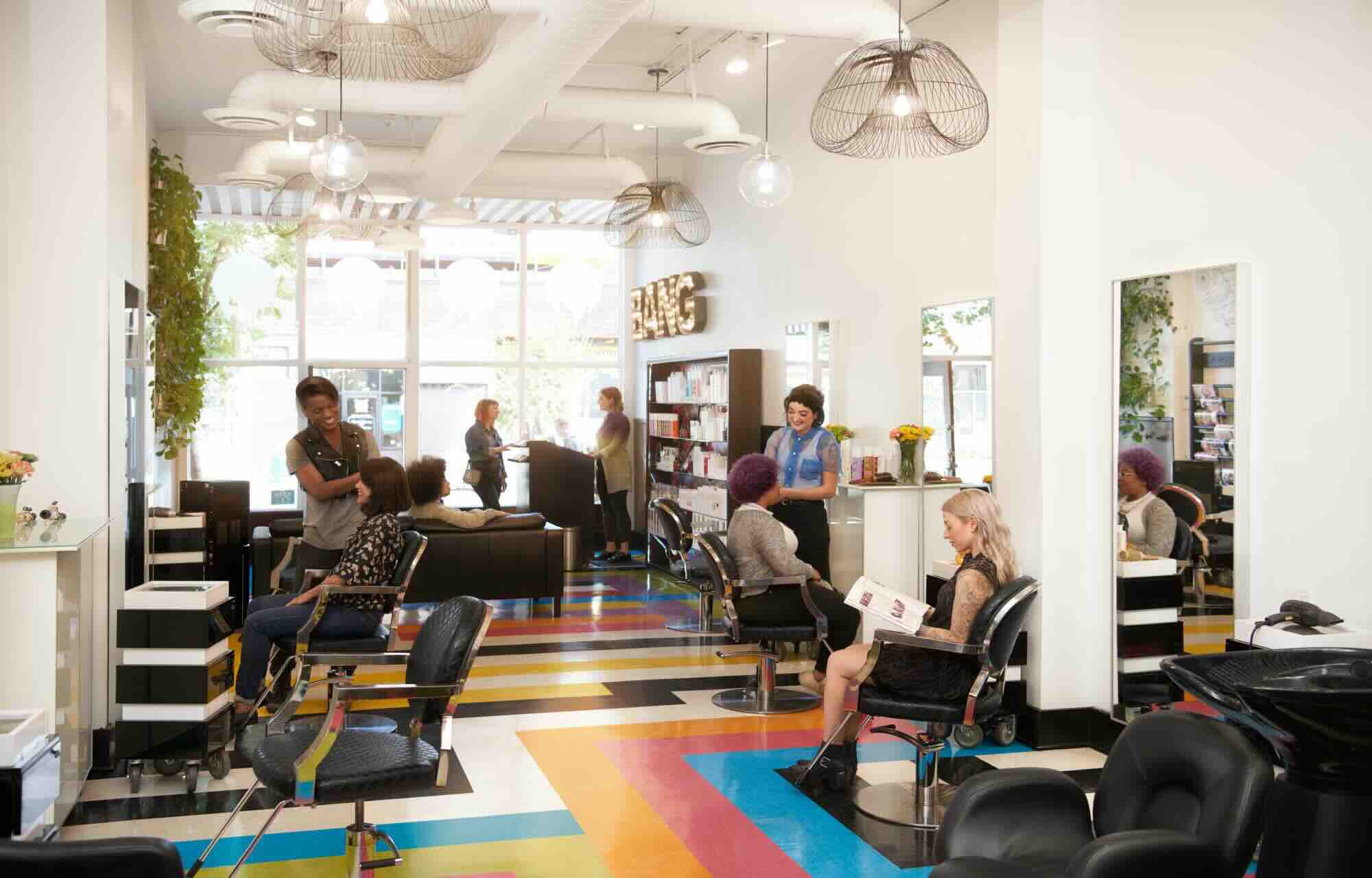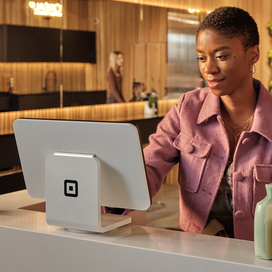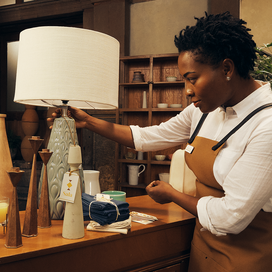Table of contents
The idea of owning a salon has been in the back of your mind for a while, but now you want to make this a reality. How can you start a salon business that is a cut above the rest?
The truth is that starting a salon is a lot like starting any other type of small business: there’s research, licensing, hiring, and plenty of decision making involved before you can open your new salon’s door to clients.
Below, we’ll answer all of your questions about opening a salon, from an initial opening checklist to a full guide of common questions.
Opening a salon checklist
Before we dive into the details, here’s a checklist of what you’ll need to accomplish as you prepare to open your salon:
- Define your salon concept. Your salon concept should be woven into every aspect of your business, from the services offered to your style of customer service. Your concept should also be reflected in the name of your salon, your design, your decor, and your price range.
- Create a business plan for your salon. Your salon business plan should lay the foundation of your operations. Be sure to include an executive summary, company description, industry analysis, geographic analysis, target market analysis, sample services, marketing plan, management strategy, and financial plan.
- Register your business. You need to register your business with the IRS to receive your Employer Identification Number, which you need to file taxes. (You can sign up for one here.) You might think about trademarking your salon’s name, too.
- Select the right location. A salon’s location can make or break its success. Think about visibility and foot traffic, and evaluate the size and interior shape to decide if it’s the best fit for your business goals.
- Order salon equipment. Equipment can get pricey, so you want to be strategic when selecting what to buy or lease. List out everything that you absolutely need versus what you want. Make decisions based on your budget and your financial analysis.
- Outline your offerings and services. Your services are the centerpiece of your salon and should reflect your concept and brand. Service descriptions are a marketing tool that can help convince new customers to try your salon, so your descriptions should be concise but appeal to your audience.
- Hire the right staff. Make a list of how much staff you need to run your business efficiently. Then get to hiring. This is also a good time to decide if you want to process payroll yourself or use payroll software.
- Create a marketing plan. Before you open a salon, it’s important to develop a marketing plan that drives awareness, brings in new customers, and creates a loyal following. Marketing tactics you might use include everything from social media to hosting a soft opening that drives hype.
How much does it cost to start a salon?
According to The Salon Business’s breakdown of costs, starting a salon can cost anywhere from $62,000 for a more basic physical salon location to up to $500,000 for a more complex salon. Startup costs for any salon business can vary significantly, but largely depend on:
- Size of the salon
- Location
- Licenses and permits
- Business structure (i.e., chair rental versus hiring employees)
- Equipment
- Operational costs
- Marketing effectiveness
- Optimizing your scheduling
Since your goal is for your salon to be profitable as quickly as possible, the best way to do that is with a little bit of planning: establish your salon startup costs, forecast your revenue potential, and find your break-even point.
First, determine the fixed costs that you incur on a monthly basis. Fixed costs are your salon’s expenses that don’t change with sales volume, and are typically non-negotiable (we call them fixed for a reason). Some of these include:
- Insurance
- Rent and lease agreement
- Utilities
- Equipment
Variable costs, on the other hand, are easier to manipulate, which can help you cut costs and save money. These are the costs of labor and materials that change with sales volume. Variable costs associated with opening a salon include:
- Labor costs
- Products and tools used by hair stylists
- Shipping and delivery costs to replenish hair product
- Advertising and marketing
After you determine your salon’s expenses on a monthly basis, you should create a revenue forecast for your first year and then determine your break-even point, which is where your revenue and expenses zero each other out.
Use this information — your expenses and projected revenue — to create a budget that keeps you on track and helps you avoid overspending.

What kind of salon equipment do I need to purchase?
You’ve just signed the papers and picked up the keys to your new salon space. One of the first things you need to do is fill your empty space. While it’s easy to get wrapped up in buying equipment, furniture, and decor, you have to remember that these things come at a price (and it’s often a high one).
Salon equipment makes up a large portion of your startup costs, and many owners tend to overspend. To keep costs reasonable for salon equipment, create a basic checklist of the materials needed for your salon. Every salon needs the following:
- Salon stations that include a chair, mirror, and storage space for hair and styling products
- Shampooing stations with a chair, shampoo bowl, and storage space for products
- Drying stations for use during coloring services
The amount of equipment you need depends on the size of your salon and the number of employees you decide to hire. Most salons have one salon station per employee, but hair stylists with opposite working schedules may be able to share a station.
A small reception area is also necessary for most salons. You’ll want a seating area for clients waiting to see your stylists, as well as a front desk. Most importantly, you’ll want a sleek point of sale for managing bookings and payments.
Pro tip
Most salon equipment and furniture can be bought at wholesale prices with your cosmetology license, which can be a great way to save money if you are buying in bulk. Check out our full salon equipment checklist for everything you’ll need for setting up your new salon.How do I hire the right hair stylists?
Hiring the right staff for your salon is essential; the quality of your staff’s work makes or breaks your salon. So before you start the interview process, create a list of what you are looking for in an ideal candidate. Here are some things to consider:
- Skill set: The candidate’s skill set and capacity to learn are both important to think about when interviewing. Think about the years of experience you want your stylists to have. Do you want each stylist to have proficiency in coloring? Or are you going to hire dedicated colorists?
- Attitude: A candidate’s attitude and work ethic determine their dependability, ability to work with others, and overall customer service.
- Personality: A candidate’s personality should match the company culture you infuse in the salon. Whether you are aiming to be an upscale boutique or a family-focused shop, you want your company culture to be naturally instilled in your employees. Think about how you want to define your company culture and the traits that each employee should have.
Obtain an Employee Identification Number.
Before you hire anyone, make sure you have an Employee Identification Number (EIN) number, which is also known as a Federal Employer Identification Number, Federal Tax ID Number, Federal Identification Number, or even a Federal EIN. This is a unique nine-digit number issued to businesses by the IRS for tax ID purposes. An EIN is like a Social Security number for a business.
Nail down the hiring and retaining process.
When you start to hire, make sure you’re following the correct procedures when hiring employees. You need to confirm their eligibility to work in the U.S., run the correct background check, obtain the correct workers’ comp insurance, and set up records for withholding taxes.
Once you’ve hired and onboarded your employees, you might feel like your job is done. Not so fast. The salon industry is competitive, and you often see hair stylists jump from one salon to the next.
In order to prevent employee turnover at your salon, you have to provide your employees with reasons to stay. Here are a few ways to boost employee engagement and retain staff:
- Build strong relationships with your direct reports and encourage team bonding activities outside of working hours.
- Outline a career path and learning opportunities for employees, and give your hair stylists an opportunity to advance.
- Promote from within before you hire outside your salon; this encourages stylists to stay.
- Offer competitive compensation compared to salons in the area.
- Provide perks like flexible hours, commuter benefits, birthday recognition, and regular happy hours to keep your employees feeling valued.
Choose the right hair salon compensation model.
You have a number of options for pay structures at your salon, including:
- Booth renters
- Independent contractors
- Salaried employees
- Employees with hourly pay
- Hourly pay with flat-rate or tiered commission
- Hourly pay with performance bonuses
Get a full breakdown of how these different setups work here.

What’s the best salon software?
Once you have stocked your salon with supplies and hired stellar stylists, it’s almost time to open your doors. But before you do, you want to make sure you have a way to accept payments and operate your business with salon management software.
POS system
Let’s start with taking payments. You want to look for a payments processor with clear pricing and no hidden fees. Your payments system should allow you to take whatever form of payment your clients want to use, including magstripe, EMV chip, and NFC (mobile payments like Apple Pay). Many younger clients are also using buy now, pay later (BNPL) to cover their more expensive treatments, so you may want to look for a point-of-sale system that offers BNPL payments in person and online.
When you are assessing different payments processors, be sure to ask the following questions:
- What is the setup process like?
You should look for a payments processing system that is easy to set up. - How fast will deposits hit your bank account after a transaction?
You want to get paid for your services quickly and not endure lagging processing time. - Is the payments processor secure?
A payments system should have security measures and be PCI compliant. Ask about chargeback protection and fraud detection to get a better sense of how protected you are.
But don’t think of your payments processor as a silo. Ideally, you want your payments processor to be integrated with a point of sale that can help you run your entire business. The right salon point of sale should integrate your payments system with other salon operations — like appointments, marketing, and team management — to make your day-to-day management more efficient.
Scheduling software
In fact, the right salon POS system can actually act as a receptionist, which can aid in your salon scheduling strategy. By integrating your online scheduling tool with your POS, customers can access hair stylists’ calendars and book appointments 24/7. You can create appointment notes on clients, and all customer information is saved in a customer directory that can be accessed in the POS system for a smoother checkout.
Additionally, you can access sales reports, customize discounts, sell online, and manage inventory in real time with the salon POS system, all of which give you a holistic view of your salon and help you manage your business from anywhere.
Square is vital to everything that we do on a daily basis. And it makes not only our reception team’s life easier, but the clients love it because it’s very user-friendly and they’re able to see exactly what’s going on with their personal schedules as well. ”
Jessica Heckman → owner of The Beautiful Co. Hair and Lashes
How do I develop a salon marketing plan?
Marketing plays an essential role in the competitive salon industry. The right marketing efforts can help your salon stand out and help build up a loyal base of repeat clients, which is crucial for any beauty business.
Build a marketing strategy based on your salon.
It’s time to go back to your salon business plan: what are your business goals, and who are your target customers? What makes your salon unique or sets it apart from the local competition? Do you sell retail products or have a tea bar on site? These are all factors to consider as you frame your business concept and market your brand.
Next, think about where your target customers find new products and services through a market analysis and determine where you want to direct your marketing efforts — whether that’s on social channels, through email marketing, or via paid ads. For a deeper dive into marketing strategies for your salon, consider new ways to attract clients to your business and use these ideas to boost your marketing efforts.
Stay up to date with industry and marketing trends.
As a beauty business, it’s no secret that staying up to date with the latest trends is key to winning new clients and keeping them coming back. Talk to your clients during their appointments about what their pain points are and what they’re interested in (this could be anything from products to treatments to how they want to hear from you), join industry forums or communities to stay on top of what’s happening, follow influencers or other prominent leaders in your space on social media, and of course, stay up to date with trends, industry reports, and data-backed findings on what beauty customers want.
As you’re gathering information, think about what applies the most to your business concept — what is your salon known for that customers want, and how can you get the word out? Also consider any new areas of opportunity — what are you learning about client interests, and is there anything new you could incorporate to cater to them? Think: new services, live classes, online tutorials, or group events. Be sure to talk to your staff and get their take on marketing opportunities and new ideas.
Offer gift cards or a referral program.
The final piece of the marketing puzzle is getting your salon some organic word-of-mouth marketing from loyal and satisfied clients. Since many salons are reluctant to offer discounts or promotions, consider offering gift cards or a referral program where happy customers can refer their friends in return for some sort of perk.
One of our most popular marketing campaigns is our annual gift card discount for Black Friday. Last year, we sold $17K in gift cards on that one day alone. ”

What makes a salon profitable?
Profitable salons come in many forms, but repeat clients and diversified revenue streams are what tend to help salons succeed in a hyper-competitive industry.
Consider offering a client loyalty program to reward your repeat clients. What you offer as part of your loyalty program is up to you, but points that clients can redeem for products and services, special offers and deals, free merchandise, invitations to special events, or the chance to test new products and services before they’re released are all popular salon loyalty program options. Once your loyalty program is up and running, it’s a very helpful tool to track client spending and boost profits.
Loyalty programs aren’t the only way to entice clients to return. Diversifying your revenue with new offerings also helps both interest and attract clients and allows your business to be more adaptable to financial pressure and industry change. Take note of how other businesses have successfully expanded their offerings, and keep in mind what clients are interested in seeing more of when it comes to new offerings at salons.
How do I open a salon with no money?
Even if you don’t have adequate savings or enough funding up front to open a salon, there are still a few options to consider. Keep in mind that before you commit to any additional investment or financing options, speak with a professional before signing anything.
Limit your up-front costs.
Consider leasing equipment so you don’t have to pay the full cost of your salon equipment up front or opening your salon in an already established business, such as a salon suite or a booth rental. Both of these options allow you to bring on clients, market your business, and build your savings without having to take out a loan or pay the full rent for a storefront.
Recruit investors.
There are plenty of avenues to raise money for your business, including:
- Consider friends and family or people in your network or community that may be interested in investing in your salon.
- Attend industry events or conferences to make new connections that could help lead to funding.
- Apply to an accelerator program that can help broaden your connections and support new business growth.
- Look into an angel investor that will provide initial funding for an eventual return on their investment.
Before you commit to any kind of investment, do your due diligence to be sure the investment is sound, or consult a legal or financial advisor.
Apply for a small business grant or loan.
If you’re set on a standalone salon that’s all your own, there are plenty of different types of business loans that can help you get there. Online lenders, banks, peer-to-peer lending sites, and lenders backed by the SBA are just a few of the types of lenders that provide loans. If you use Square, you may be eligible for a customized loan that you can automatically repay with a percentage of your sales.
I absolutely love Square Loans. They offer pre-approved loans, clearly outlining how much you can borrow, the repayment terms, and a one-time fee. I don’t even have to think about putting money aside or paying off the loan. The loan paid off itself.”
Nikki Ally Rae → hair stylist and owner of Be You Hair
Why do some salon businesses fail?
Sticking to your business plan, relying on the right salon management software, and ensuring you have a loyal client base will help your salon remain profitable. That said, some salon businesses do end up closing, so keep the following scenarios in mind as you plan and operate.
- Inadequate cash reserves. You need cash reserves for unexpected costs and fees that you may incur when you are opening a salon.
- Lack of industry experience. Without expertise in the industry, you can struggle with day-to-day operations and forecasting for future growth. Many top-performing salon owners have been in the industry for many years.
- Failure to keep up with trends. Salon trends change frequently, and sticking to your old ways can lead to a downturn in business. Promote continued education for your staff and encourage them to learn new skills and expand their services.
- Failure to manage appointments. Salon owners who find it difficult to manage walk-in appointments and reoccurring clients often have a hard time staying afloat. It is essential to warmly welcome walk-in customers without tarnishing relationships with existing clients and bogging down the scheduling system.
- Competition. Because of the industry’s saturation, competition is a top struggle for many salon owners. Owning a salon is a lucrative business that attracts a lot of entrepreneurs, so it is important to constantly assess neighboring salons and remain competitive with prices, services, and overall customer service.
How can I make running and operating my salon easier?
There are plenty of aspects that make operating your salon easier, like reliable staff and a consistent cash flow, but the right salon management tools and software can make or break your operations.
Square for Beauty is built for and used by salons across the globe, helping sync and simplify all sides of your business so you can save time and focus on clients and growth. Allow clients to book 24/7, take payments anywhere, automate scheduling, and manage your entire team and multiple salon locations — all from a centralized point of sale.
All loans are issued by Square Financial Services, Inc., a Utah-Chartered Industrial Bank. Actual fee depends upon payment card processing history, loan amount, and other eligibility factors. A minimum payment of 1/18 of the initial loan balance is required every 60 days, and full loan repayment is required within 18 months. Loan eligibility is not guaranteed. All loans are subject to credit approval.
Square Checking is provided by Sutton Bank, Member FDIC. Square Debit Card is issued by Sutton Bank, Member FDIC, pursuant to a license from Mastercard. Square Debit Card may be used wherever Mastercard is accepted. Accounts are FDIC-insured up to $250,000.
![]()














